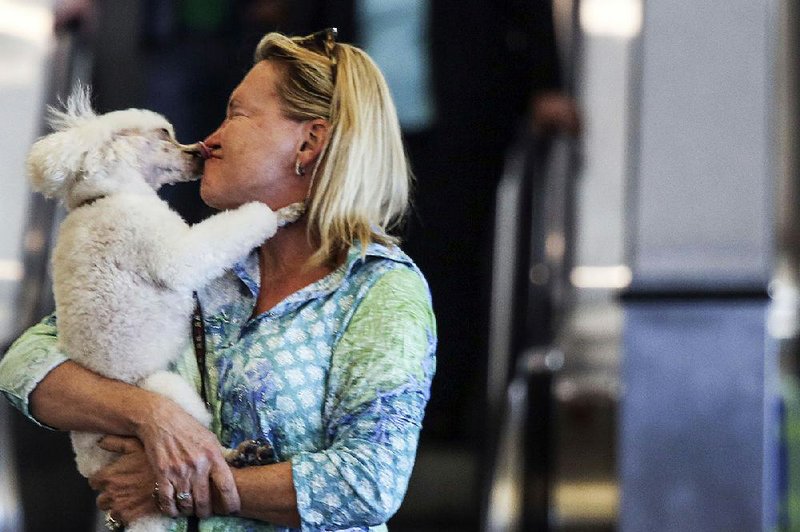A projected 1 percent increase in passenger boardings in 2018 at Bill and Hillary Clinton National Airport/Adams Field helped shape its proposed $34 million operating budget for next year, airport officials said.
The proposed budget represents a 1.2 percent increase over the $33.6 million operating budget the state's largest airport expects to finish with in 2017.
"The level of passenger activity directly impacts concession revenues (parking, rental cars, terminal concessions) and the 2018 budget for these revenue sources reflect the anticipated increase in passengers," airport officials said in budget documents prepared for the Little Rock Municipal Airport Commission, which oversees Clinton National.
The airport expects to finish 2017 with slightly more than 2 million passengers arriving and departing the airport.
Through November, a total of 1,866,415 passengers have gone through Clinton National, which is 1.97 percent, or 36,038, more than the 1,830,377 passengers who went through the airport through first 11 months of 2016.
The increase reverses a trend driven by airline mergers that saw a decline in passenger traffic at Clinton National and other small-hub airports while it grew at large- and medium-hub airports.
Moody's Investor Service has said it expects the trend to continue in 2018, thanks to the addition of budget airlines such as Allegiant Air, which provides seasonal service to and from Clinton National that is aimed at leisure travelers.
The airport expects to see airline revenue rise to $11.7 million in 2017, a 1.8 percent increase over 2017. Nonairline revenue, which includes parking, rental car fees, restaurants and other concessions, is expected to rise 1.2 percent, to $22.4 million.
Expenses will total about $23.5 million, which is 10.8 percent over the $21.2 million with which the airport staff expects to finish this year. The 2018 figure is 2.8 percent more than what was budgeted in 2017.
The rise on the expense side is due to filling vacancies in some executive staff positions, a rise in health insurance premiums, and increases in what the airport pays for police officers and firefighters, who work for the city but are assigned to the airport under an agreement in which the airport pays their salaries and benefits, according to airport staff.
Salary and wages are expected to be $8.5 million in 2018. The airport budgeted $8.2 million in 2017 but expects to finish the year at $7.6 million because of the vacancies.
Employee benefits are expected to total $4.1 million next year, up from $3.3 million in 2017, due in large part to the health insurance premium increases.
Professional and contractual services, which include police and firefighters assigned to the airport, are projected to total $4.5 million next year, up from $4.2 million in 2017.
The finance committee voted Friday to send the proposed budget as well as a resolution raising the fees on airlines to the commission, which is to take it up at its monthly meeting Tuesday.
Stacy Hurst, chairman of the commission's finance committee, called the budget "very thorough."
"You've obviously put a lot of work and thought into that," she told the staff.
Commission Chairman Jim Dailey, who will participate in his last meeting after serving two five-year terms, agreed.
"I continue to be impressed at how this staff continues to keep this airport so significantly financially stable and sound," he said after Friday's meeting. "And at the same time, we continue to see [boardings] coming up a little bit.
"I think things are really running very well."
Dailey said he was particularly pleased to hear the airport won't raise parking fees. At $9.6 million in 2018, they account for a significant portion of the airport's nonairline revenue.
"To hear that there's not going to be any new increase in parking fees resonates with me," he said.
The proposed budget also anticipates increases in landing fees and the passenger terminal rental rate, which is the principal way airlines pay to use the airport.
The airport staff wants commission approval to increase the landing fee to $4.17 per 1,000 pounds of landed weight, which is 5 cents more than the $4.12 the airport is charging in 2017.
Landing fees are charged to all passenger and cargo aircraft as well as all chartered flights and cover the costs allocated to the parts of the airport system they use, which include the airfield, apron loading bridges and terminal building space.
In response to a question from Hurst, airport staff said the increased fees amounted to $200,000 spread across the five airlines that use Clinton National.
The rate the airport charges airlines for using the passenger terminal also will rise under the proposed budget. It now is $38.90 per square foot. In 2018, airport staff proposed the rate be $41.07 per square foot, a 5.6 percent increase.
The airport expects to finish 2018 with $10.7 million in the bank after expenses are deducted from revenue.
Metro on 12/16/2017

